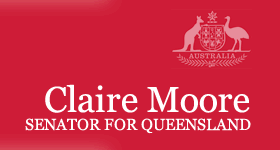Senator MOORE (Queensland) (18:36): I will seek leave to continue remarks at the end of my contribution, so we will not need to rely on Senator Macdonald.
I also seek to take note of the minister's statement. I thank the minister for his first update to the Senate on the current process of the northern Australia white paper. We know that the white paper is part of a compilation of existing government programs and initiatives sprinkled with new spending commitments.
The minister's statement highlights a number of important milestones. We are pleased to finally welcome the appointment of Ms Laurie Walker as the CEO of the Northern Australia Infrastructure Facility. The Northern Australia Tourism Initiative, which provides $13.6 million for small and medium tourism businesses to get one-on-one business advice, combines the Entrepreneurs' Program-which was formerly known as the Entrepreneurs' Infrastructure Program-with the Australian Small Business Advisory Services program. This is a welcome initiative, but we believe it does not go far enough.
The government has also committed $75 million over the next 10 years to establish a new cooperative research centre in Townsville, and we welcome that in the wonderful northern city of Townsville. The idea to establish a CRC responsible for developing northern Australia is not new. It was first flagged in the coalition's June 2013 election policy, The Coalition's 2030 Vision for Developing Northern Australia. It was apparently on Mr Ian Macfarlane's desk for sign-off before Mr Turnbull replaced Mr Abbott in September last year.
Then, in November last year, John Wharton was appointed to run consultations with stakeholders and participants again on the direction and research agenda for the CRC, and it was supposed to commence in the middle of this year. But like some of the initiatives-indeed, most of them-included in the white paper, we are still waiting.
It has also been more than a year since the Abbott-Turnbull government first announced the Northern Australia Infrastructure Facility-NAIF-and still no funds have been allocated to projects in the region. In fact, only one formal application for funding has progressed to due-diligence stage. When asked last month whether funding would flow before the end of this year, the minister could offer no guarantee.
After rushing legislation through this parliament in the last sitting week before calling the election, Mr Turnbull spent the election campaign in northern Queensland promoting the NAIF. In May the Prime Minister said:
… the commitment to Northern Australia from our national economic plan is enormous. We have a $5 billion, Northern Australia Infrastructure Fund that will be providing loans across Northern Australia …
Then, in June 2016, he also said:
Well our focus is on jobs, jobs and growth and particularly in Northern Australia. As you know, we have massive investment in the Northern Australia infrastructure fund …
It was the same talk about jobs-jobs and investment in the north. Residents and businesses are tired of a Prime Minister who talks a lot about this but who has not delivered on it. With high unemployment across northern Australia, the Turnbull government must begin to invest and create the sustainable jobs that the locals need and have heard so much about.
The minister mentioned tourism in his statement. We all know that tourism is one of the biggest employers in northern Australia. But a lack of high-quality facilities and tourism infrastructure limit our ability to increase our share of the growing Asian tourism market. Tourism is our third biggest export in value terms behind iron ore and coal. It accounts for one in every twenty export dollars. But the World Economic Forum's latest travel and tourism competitiveness index ranked Australia seventh for overall competitiveness and 20th for tourism infrastructure.
We have some of the world's most amazing natural environment experiences, but we risk being dragged down by substandard tourism infrastructure. The government has a key role to play here in supporting investment in world-class infrastructure which underpins a world-class tourism experience.
By 2030 there will be more than three billion middle-class people in Asia looking for tourism opportunities in our region and beyond. We want them to choose Australia. Cruise tourism, also, is growing 20 per cent a year, creating more demand. Airports in the north are also seeking to expand to meet expected demand. Without world-class facilities, we are not going to be able to compete, sending our necessary jobs overseas.
At the last election we made the commitment to allocate $1 billion from the Northern Australia Infrastructure Facility to a Northern Australia Tourism Infrastructure Fund to boost partnerships with the tourism sector and to provide incentives for investment in new and upgraded tourism infrastructure across the north. The government could do this, but they have not. They did not even take a tourism policy to the last federal election.
To make matters worse, since the coalition government announced its flawed review into the backpacker tax, both the number of backpacker visitors to northern Australia and the number of nights they stay have seriously declined. In fact, lodgements for working holiday visa applications have fallen 10 per cent under the coalition. There were 24,000 fewer backpackers present in Australia at the end of 2015 compared to the same time in 2013.
We know that the backpacker tax has been a mess from day one. In fact, in many ways the backpacker tax tells you everything that is wrong with the Turnbull government. After more than a year of unnecessary pain and uncertainty for agriculture and tourism, the Turnbull government has now finally backflipped after pressure from the northern Australian George Christensen and the right wing of the party, who are really running the government. Labor will carefully examine backpacker tax mark 2, but one thing is for sure: decisions like the backpacker tax show the government takes northern Australia for granted.
The government's plan to develop northern Australia also largely ignores its most important resource-its people, in particular its Aboriginal and Torres Strait Islander people. We heard from the minister that there are programs in train into the future. We also know that 30 per cent of the population of northern Australia is made up of Aboriginal and Torres Strait Islander people. A critical part of unlocking the potential of northern Australia is increasing the capacity of the Indigenous population to contribute to the development of the region.
This involves building more than just hard infrastructure. It also means building skills and tackling chronic problems related to housing and health. However, the white paper says very little about that. In fact, the Aboriginal and Torres Strait Islander community of northern Australia seems to have not been really consulted in the development of the white paper.
During the question and answer session at a recent CEDA event the minister told the audience that native title is one of the biggest barriers to growing agriculture and crops. Comments like this create the impression that the government sees Aboriginal and Torres Strait Islander landowners and custodians as an obstacle to the development of the north, rather than, in fact, the key.
Native title is of particular importance to northern Australia, as the majority of determinations and current native title claimant applications are in Western Australia, the Northern Territory and Queensland. Roughly 80 per cent of northern Australia is directly or indirectly Aboriginal and Torres Strait Islander land. The government needs to stop viewing Indigenous land rights as an impediment to development and embrace native title and traditional land ownership as cultural, social and economic assets.
One of the Indigenous leaders who has been very critical of the white paper process and the lack of consultation is Peter Yu. In June of this year he spoke at the developing Northern Australia conference in Darwin and said there that there had been no formal engagement between the Aboriginal and Torres Strait Islander people and the government over the future development of northern Australia.
The Prime Minister has failed to reverse a single dollar of the $500 million in cuts that Mr Abbott, as leader, made to Indigenous programs and frontline services. Despite a promise that there would be no jobs or services lost, in fact, the opposite is true. At the last election Labor committed to doubling the number of Indigenous rangers employed under the working on country indigenous ranger program. The Turnbull government is refusing to give Indigenous rangers the long-term job certainty they deserve. Indigenous rangers are role models in their communities, with the program providing a pathway to work and a profession that has been shown to improve Indigenous health, incomes, crime rates and incarceration rates. That is how we can meaningfully close the gap: practically-one step at a time.
As the minister's report shows, there is still much work to do to, we hope, translate those big expectations into concrete, deliverable outcomes that will have a lasting impact. Labor looks forward to continuing to work with the government to actually achieve those outcomes, and we look forward to further reports to the Senate on progress towards implementing the northern Australia white paper. I seek leave to continue my remarks.
Leave granted.




